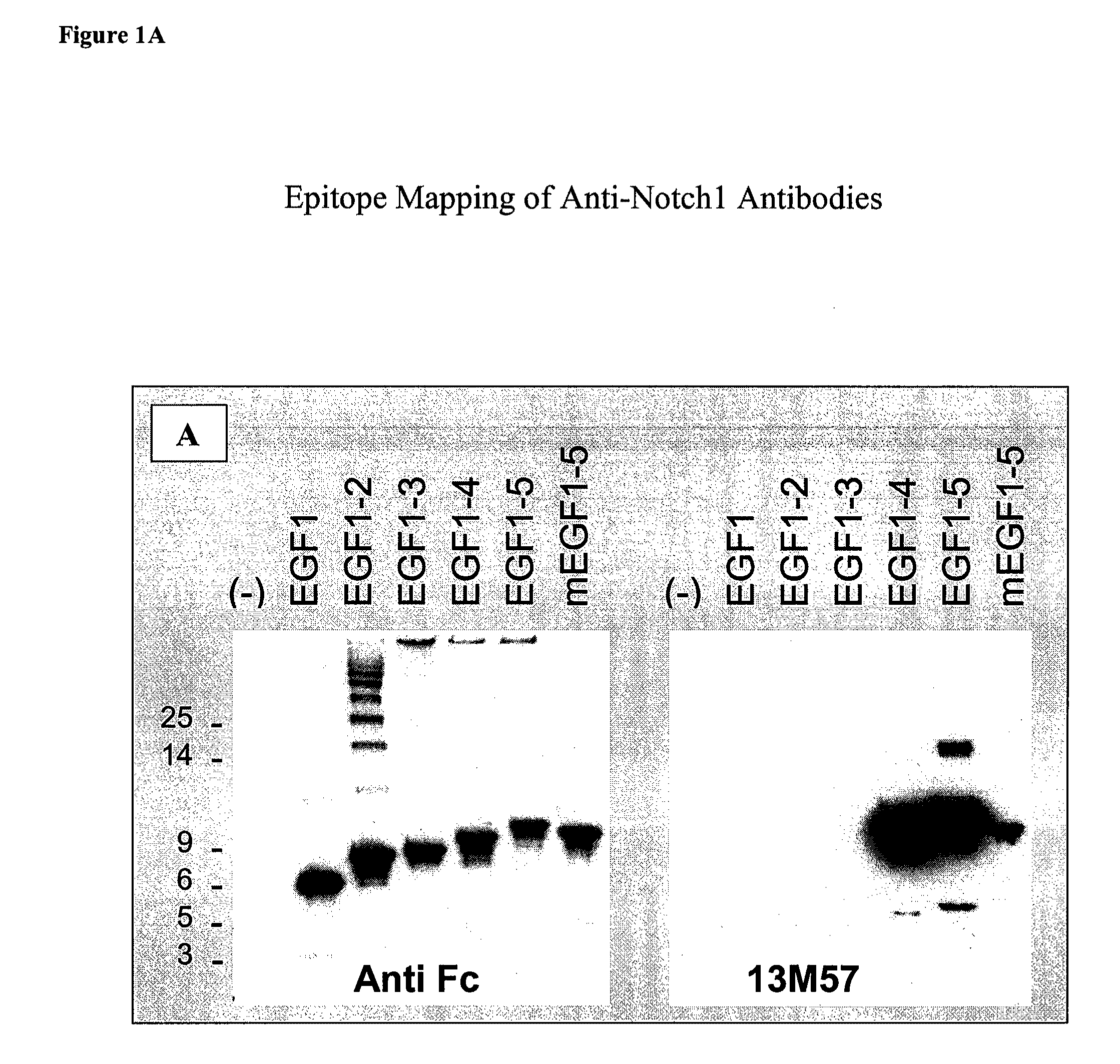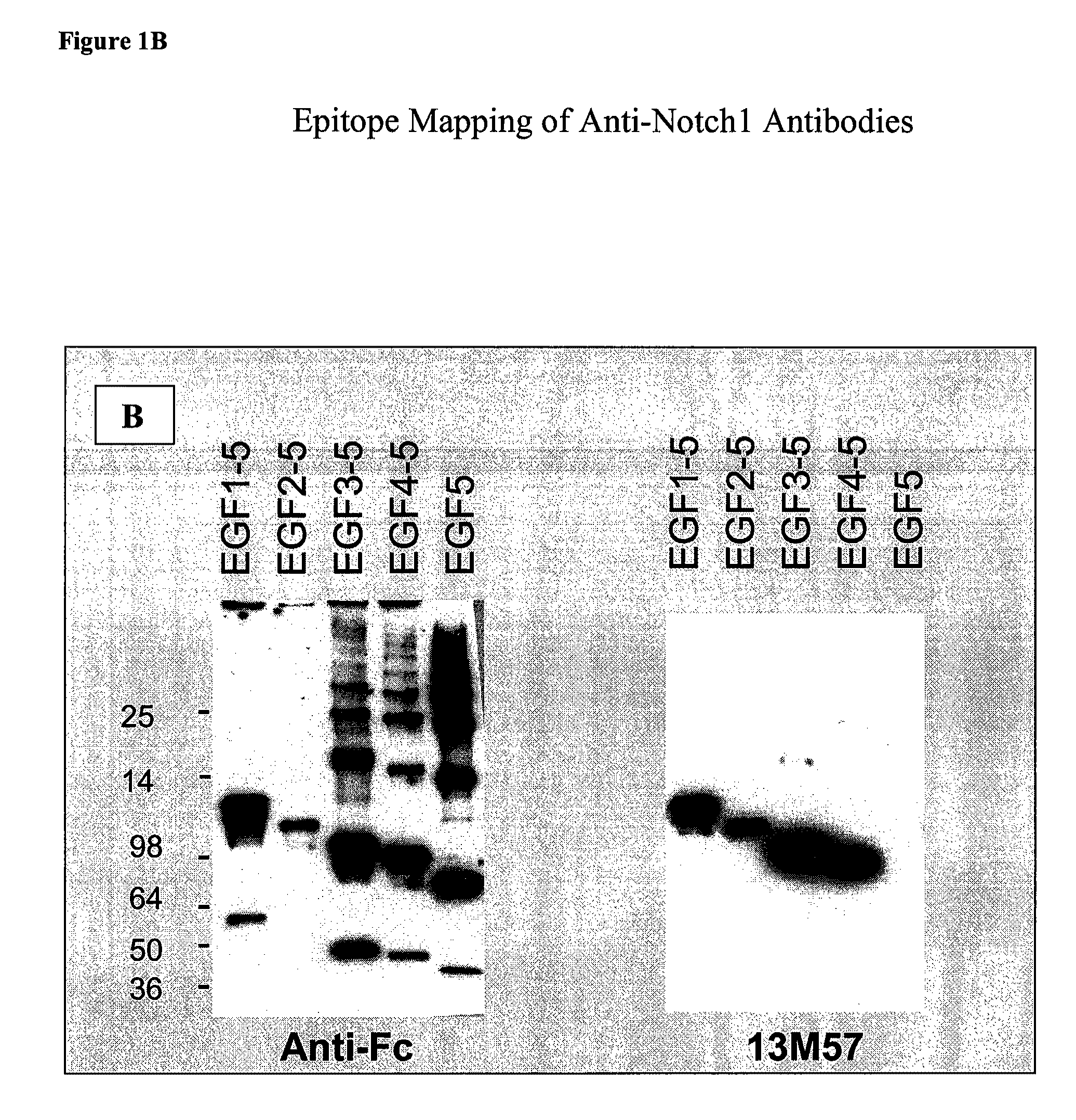Compositions and Methods for Diagnosing and Treating Cancer
a cancer and composition technology, applied in the field of cancer, can solve the problems of increasing mortality, reducing mortality rate, and limiting the approach, and achieve the effect of inhibiting tumor cell growth
- Summary
- Abstract
- Description
- Claims
- Application Information
AI Technical Summary
Benefits of technology
Problems solved by technology
Method used
Image
Examples
example 1
Production of Humanized Notch1 Antibodies
Antigen Production
[0173]A recombinant polypeptide fragment of the extracellular domain of human Notch1 was generated as an antigen for antibody production. Standard recombinant DNA technology was used to isolate a polynucleotide encoding amino acids 1-220 of human Notch1. This polynucleotide was ligated in-frame N-terminal to either a human Fc-tag or histidine-tag and cloned into a transfer plasmid vector for baculovirus mediated expression in insect cells. Standard transfection, infection, and cell culture protocols were used to produce recombinant insect cells expressing the corresponding Notch1 polypeptide (O'Reilley et al., Baculovirus expression vectors: A Laboratory Manual, Oxford: Oxford University Press (1994)).
[0174]Cleavage of the endogenous signal sequence of human Notch1 was approximated using cleavage prediction software SignalP 3.0, however the actual in vivo cleavage point can differ by a couple of amino acids either direction....
example 2
In Vivo Prevention of Tumor Growth Using Anti-Notch1 Antibodies
[0187]This example describes the use of humanized anti-Notch1 antibodies to prevent tumor growth in a xenograft model.
[0188]In certain embodiments, tumor cells from a patient sample (solid tumor biopsy or pleural effusion) that have been passaged as a xenograft in mice were prepared for repassaging into experimental animals. Tumor tissue was removed under sterile conditions, cut up into small pieces, minced completely using sterile blades, and single cell suspensions obtained by enzymatic digestion and mechanical disruption. Digested cells were filtered through a 45 μM nylon mesh, washed with RPMI / 20% FBS, and washed twice with HBSS.
[0189]Dissociated C8 colon tumor cells were injected subcutaneously (n=10,000) into the flanks of NOD / SCID mice to elicit tumor growth. Treatment was initiated two days after cell injections: antibodies were injected i.p. at 10 mg / kg twice a week and irinotecan was given i.p. at 7.5 mg / kg onc...
example 3
In Vivo Treatment of Tumors Using Humanized Anti-Notch1 Antibodies
[0191]This example describes the use of humanized anti-Notch1 antibodies to treat cancer in a xenograft model. In certain embodiments, tumor cells from a patient sample (solid tumor biopsy or pleural effusion) that have been passaged as a xenograft in mice are prepared for repassaging into experimental animals. Tumor tissue is removed, cut up into small pieces, minced completely using sterile blades, and single cell suspensions obtained by enzymatic digestion and mechanical disruption. Dissociated tumor cells are then injected subcutaneously either into the mammary fat pads, for breast tumors, or into the flank, for non-breast tumors, of NOD / SCID mice to elicit tumor growth. Alternatively, ESA+, CD44+, CD24− / low, Lin− tumorigenic tumor cells are isolated as described in detail above and injected.
[0192]Following tumor cell injection, animals are monitored for tumor growth. Once tumors reach an average size of approxima...
PUM
| Property | Measurement | Unit |
|---|---|---|
| Tm | aaaaa | aaaaa |
| temperature | aaaaa | aaaaa |
| size | aaaaa | aaaaa |
Abstract
Description
Claims
Application Information
 Login to View More
Login to View More - R&D
- Intellectual Property
- Life Sciences
- Materials
- Tech Scout
- Unparalleled Data Quality
- Higher Quality Content
- 60% Fewer Hallucinations
Browse by: Latest US Patents, China's latest patents, Technical Efficacy Thesaurus, Application Domain, Technology Topic, Popular Technical Reports.
© 2025 PatSnap. All rights reserved.Legal|Privacy policy|Modern Slavery Act Transparency Statement|Sitemap|About US| Contact US: help@patsnap.com



